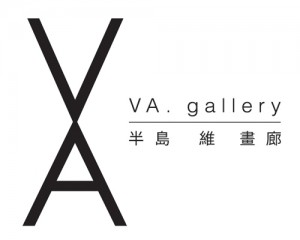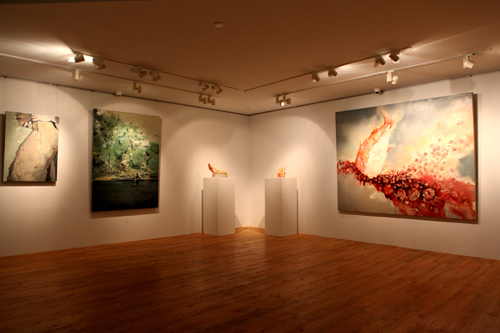Venice Biennale 2009: interview with Tian Tian Wang
Tian Tian Wang (born in Qingdao -– People’s Republic of China – in 1980) currently lives in Germany. Tian Tian is going to exhibit her artworks in Venice at the 53rd Biennale of Art: “By painting I want, as a storyteller, to create from two-dimensional objects a place where a Legend takes place”. Her curriculum vitae can be seen on her offical website together with her artworks. Tian Tian kindly accepted to answer to our questions regarding her work and her exhibition in Venice.
Q. Tian Tian, what are you going to show at the Biennale?
A. Almost all of my important works. You can recognize two phases, at first there are the mountains, they are my phase of “classic panting”. Since 2005 starting with “Paradise” I started to work differently.
Q. What do you feel might be the result of exposing at the Biennale, in such a sacred and revered place for contemporary Art but at the same time a place where the artist’s creativity may be bound and influenced by this (over?)exposure?
Q. What’s the difference between your studies in China and those in Germany?
A. I did not study in Chinese art academy. I came to Germany when I was 19 years old. I directly wanted to study in Europe as it was the home of all the artists that impressed me from the beginning like Da Vinci, Rubens, Modigliani, Van Gogh, Balthus, Chagall… Art education in China is relatively conservative, you have to stick to a plan. In Germany the schedule is more free, the emphasis is a lot more on how to express oneself, on self analysis and finding one’s own way in art. Personally I prefer it that way, but I am also very glad that I had a more stringent training as a start.
Q. How can you explain to our readers the differences between current artistic scene in China and in Europe?
A:I have never lived in China as a professional artist. My impression of the Chinese Art Scene is, that there is a huge energy, mixed with desire and passion for art. It is a phenomenon in the history of art.
Q. This year is the 20th anniversary of the Tiananmen Square protests and massacre, whose pictures and videos in 1989 were broadcast all over the world and deeply shocked the public opinion in Italy as well as in the rest of the Western countries. Do you believe that China has started changing since that day?
A:I haven’t experienced the protest by myself. At that time I was still in elementary school. But when I caught up the occurrence as an adult I think this is absolutely a significant changing point for China.
Q. How has Chinese society influenced your artwork? Are there any social implications in your art?
A:I have a growing interest in global social phenomenons, economy and politics, also Chinese. When I was younger I was afraid to go deeper into these topics, because they would have been a heavy burden for my soul. On the other hand those phenomenons are quite short-lived. Most of the core problems in society are to be analysed in human nature and psychology. That would be the more important topic to study. Since 2005 I have also brought in this topic into my works.
Q. Do politics, religion, faith or their lack play an important role in your art? A. I started to read books on research in politics an society, but I still don´t read newspapers. I don´t belong to any religious group. Having one’s own individual attitude to those topics is very important, but they do not influence my work. It’s more the spiritual search that inspires me and I’m also fascinated by human psychology. You’ll find some of it if you take a closer look at my text on my homepage.
Q. Can you tell a name of a classic artist that has guided you through your artistic education?
Q. And what about a contemporary artist?
A. I find a lot of contemporary artists really brilliant, but since a point in the past I don’t let art inspire my art directly any more.
Q. Since 2002 in your paintings you have been making use of same symbols such as volcanoes/mountains/chimneys and smoke/clouds: what do they stand for? A.Volcanoes, mountains and clouds are my main metaphors for nature which is my biggest inspiration/topic. I choose them as symbols because they correspond to me and my feelings most. Since 2005 you find chimneys, burning houses and smoke, emerging from explosion. I also understand them as nature, they are still part of the materialistic world. In these series I would like to emphasize that beauty can also coexist with unpleasant situations, apart from distinction of the human mind.
Q. When did you first realize that art would be a significant part of your life?
Q. Where do you think lies the source of your creativity?
Q. Relationship and/or impression with Italy?
A. My Relationship with Italy started in my childhood and in a quite funny way. My father is a tenor, so I grew up with Opera. His biggest hero is Luciano Pavarotti, so he rehearsed a lot of his songs, although he did not understand a single word of Italian. He transcribed the lyrics into an absurd mixture of Latin letters and Chinese characters. In the end it sounded quite original, but did not make any sense at all. Important to name in connection with Italy are of course like Da Vinci, Rubens, Modigliani and Tizian… Finally I’d like to point out, that Italy in this context is an extraordinary influence for the two generations in my family. Hence I’m really thrilled to show my works in Italy.



